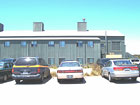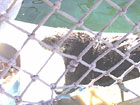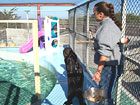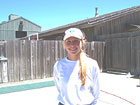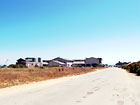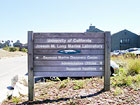

 | |||||||
|
|
Journals 2004/2005Barbara Simon-Waters
July 12, 2004 I do not know where to begin. I did SO much today! I woke up early, ready to go. I had figured out how to get to the Long Marine Lab via Route 1 to Swift Street. And I found it with little difficulty. I did find myself in the wrong lane for Route 1 but switched in the nick of time. I turned on Delaware Street and went past the Fish and Game Building and the NOAA Lab. I found the Ocean Health Building and sat in the lobby. I was early (about 8:20am) and Laura Yeates had mentioned that we would meet about 9am. I looked at everyone that entered the building. I immediately recognized Laura from her online picture. We looked for Carey Kuhn and someone else knew where she was. After all the introductions, we sat down and worked out a potential schedule. It was at this time that I presented Laura and Carey with the ARMADA Project hats (before I misplaced them!) They were thrilled! Laura gave me a tour of the facilities and I met SO many people. She wanted to introduce me to them all so they would at least recognize me and know that I was supposed to be there. Since they have captive animals there, they do not want people wandering around, possibly affecting the animals. I met the parrots first-Weeki, Mary, and Junior. I was warned that Junior bites and not to get too close. They are in the side room where the lab volunteers store their stuff so the birds are stimulated by people throughout the day. They were moved later in the morning to the outside near the Atlantic bottlenose dolphins. There are signs on the doors where the birds are kept (there is another room with birds) to watch out for the squirrels. I guess squirrels like to come into the rooms where the birds are kept to gobble up all the spilled food from the birds. Laura said that these squirrels are fat from all the snacking on bird food. I then met the dolphins who were happy in their pools doing tricks of all sorts. They were "rejects" from the Navy according to Laura. They had been "trained" to do something of sorts but one would not return until the next morning and the other refused to do it. So the Navy gave them to the lab for research animals. They were working with a trainer and a vet student from Scotland at the time. I then met one of the people involved in the feeding and care of the animals. At that time, Morgan and Wick began making all sorts of crying noises. These were the otters. They made a racket. One had been released back into the wild but kept trying to mate with seal pups severely hurting them and even drowning them. Before that he had been at the Monterey Bay Aquarium but made so much noise with his crying, that they did not want him either. This otter also bothered kayakers climbing into their boats and even bit swimmers. As a result, he was captured and brought to the lab, never to be released into the wild again! Jen fed them a wonderful array of squid, fish, shrimp, and clams. She said the food cost about $400 per week and they paid top dollar for great seafood for the animals. The otters loved to eat! They had been taught to eat with their paws only so as not to mistake the feeder's fingers for food. Food is never offered directly to them from a hand. They chewed it so quickly. I was amazed at not only how much they ate but the voracity of their eating! Jen had Morgan stand up on his hind flippers and walk. She even had him wave to us! Laura then took me to the Fish and Game office to show me where her office was located. There was a skeleton of an otter in there and she showed me the orientation of the teeth. She said that they can only grind in a certain way and that is why they can crush through shells and crabs. We went back to the lab and I met up with Carey with whom I stayed the rest of the day. I met the elephant seals, LT and Forrest. Both were about two and a half years old. Both had dark gray fir that felt smooth and fine to the touch. Neither had the characteristic "big nose" of the adult males. According to Carey, that does not develop until they are about four years old. Both of them looked at me with huge, black eyes and made grunting noises. They were anxious to be fed. I also met Samantha "Sam" Simmons, a physical oceanography student. Both Sam and Carey were lecturing to a class from 12pm-3pm. I planned to and did sit in on the class. We ate a quick lunch before the class. Basically, we ate quickly as Carey needed to get the projector for the PowerPoint set up in the lecture room. I was amazed at how many students showed up late for the class. One student came in a half hour late. I knew most of Sam's lecture because I teach the same information in my class. However, Carey's lecture was mainly new to me. She mentioned about the Fine Ratio, hydrodynamics, and energetics for otters, otariids, phocids, and cetaceans. She mentioned the body shape design and the undulations of the spinal column for determining speed of the animal. After the class we met up with Gitte (short for Brigitte) who works with seals too. We were going to place a device to measure stomach temperatures during feeding events that would continue to monitor temperature even after feeding events. It is small, cylindrical and gives off a pinging sound. Carey places it a piece of soft, non-toxic foam and glues it in. She said that she folds it in such a way to simulate the shape of a fish while feeding. This shape does not allow the animal to easily pass the monitor through its digestive system. The next part was really interesting. Carey, Gitte, and I got all the equipment together that we needed for placing the device into LT. First, LT had to be lured out of his pool into the open. Boards with handles act as a shield to prevent bites from the animal's open mouth when it lunges. It was sort of scary but now I realize that they can not move very quickly. Carey also said that loud noises such as stomping or slapping your hand against your thigh would frighten them away. They were also afraid of the board shields and would most likely back away. Carey managed to stick a syringe with a sedative into LT who quickly became very docile. I recorded the type of sedative and the dosage in her lab book. Carey then administered several CC's of two drugs that really subdued LT. Although, LT was not knocked out cold, he was unresponsive to the next step. Once it was determined that LT was "out" primarily by pinching him in the nose, the next phase started. Gitte took two pieces of rope to hold the mouth open while Carey placed the devise on the end of a long, orange, plastic tube coated with KY jelly to make go easier down the esophagus. LT did not even winch or respond. She then looked at the transmitter which was not picking up the signal of the device. She had to reinsert the orange tube to push the device farther down into the stomach. She looked at the transmitter and saw the intermittent red light flashing. The device was working. I looked at it too. We then had to let LT recover from the intubation process. He had to be alert enough prior to letting him back into his pool and that would take about an hour or so. We then prepared the fish for feeding Forrest and LT. Forrest could not wait to eat and made it known that he was ready by making noises as we passed his pen. We prepared 4 kg of herring for Forrest and 1 kg for LT. Since he was newly implanted with the device, Carey said that she typically did not feed them a lot of food after the procedure. We weighed out the appropriate amount of frozen fish and then had to bring the fish to the same temperature as the animals' pools. Both pools were 15.9 C as measured by using a temperature probe. We thawed the fish in buckets and Carey cut two slits into the flesh on one side of all the fish. This enabled her and then me (once she showed me how to do it) to monitor the temperature of the herring. She wanted them to be the same temperature as the pool water so that she would know the temperature of the fish entering the stomachs of the animal and could monitor the temperatures of the feeding events. Preparing the fish was a process of warming and cooling the fish and measuring the temperature using the probe. Finally, both buckets were at the appropriate temperature and I fed the animals. We first fed Forrest. We climbed into Forrest's pool area. It was somewhat unnerving to do this until Carey said that it would take him time to get out of the pool so we could easily be out of the way before anything happened. I have never been so close to an animal that size without a fence or protective glass between myself and the animal. To prevent Forrest from knowing that I was feeding him, Carey distracted him so that he would not be looking at me as I threw the fish into the pool water. I scattered them around the pool to simulate fish in the wild. I reserved three fish just in case Forrest did not notice some of the fish lying on the bottom of the pool, and I would throw the additional fish in to attract his attention to the rest of the fish. Carey timed the entire feeding event. It took Forrest just 2 minutes to scarf up 4 kg of herring. We then fed LT who ate his 1kg meal in .7 minutes. The timing started at first bite and ended with the last. We then went back to the lab and cleaned all the buckets for tomorrow. I was at the lab from 8:20am until 6:30pm today. Tomorrow we are going to Ano Nuevo to capture another elephant seal of the right size, sedate the animal, and bring him back to the lab for additional feeding trials. Carey lined up about 6 people for the task along with someone to operate the forklift to remove the seal from the vehicle and place him in the pool with Forrest. It should be interesting. I had a great day....learned a lot and experienced so much. I feel that I know this group already. Everyone is so friendly and willing to take the time to explain it all to me. I found it to be a fascinating day. Gitte is presenting a poster session for an international conference on Antarctic research in Bremen, Germany later in the month. What an incredible poster. It is 11pm so I better head off to bed. We are meeting at the lab at 7:30am for our trip to Ano Nuevo. (Click on thumbnails below for full version pop-up) Return to Journals Index |
||||||
